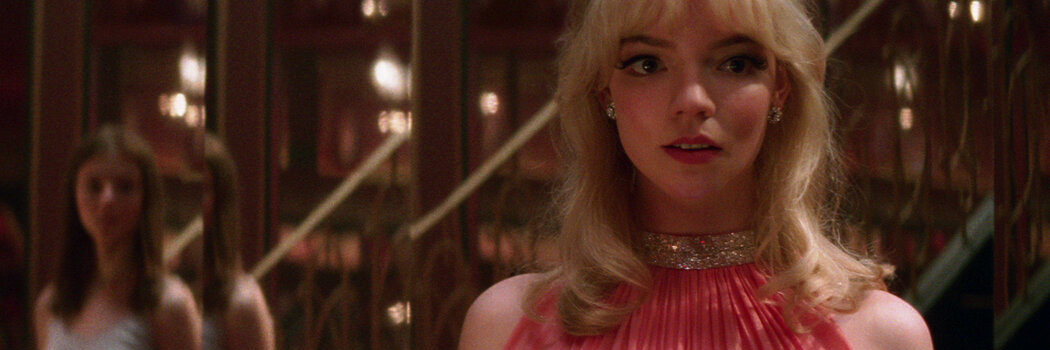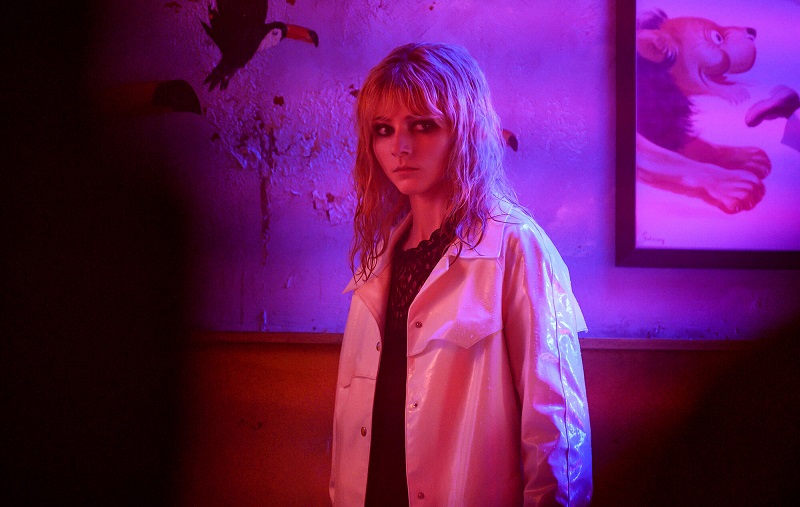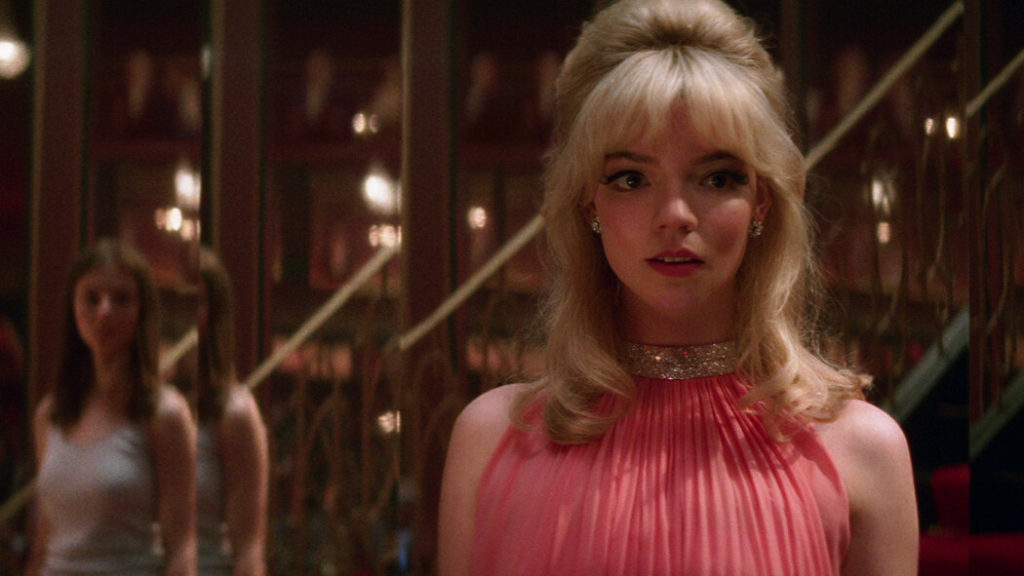Baby Driver hit screens in 2017 and was The Movie Mensch’s number one movie of that year. It may have taken the filmmaker a few years, but Wright has returned with a stunner of a film—now available on DVD, Blu-ray, and digital formats. Last Night in Soho features the “It Girl” of the moment in the extremely talented Anya Taylor-Joy (from The Queen’s Gambit and Emma fame), and Thomasin McKenzie, who broke out with her turn in Jojo Rabbit, who also was the best thing about M. Night Shyamalan’s Old.
It’s a mind-bender that splits its time between current-day London and the swinging sixties in the English capital. Wright begins his Soho journey with Eloise (McKenzie). She is the epitome of small-town, rural anywhere for that matter. Her fashion sense has gotten her into the most prestigious design schools in Londontown to fulfill a lifelong dream. Immediately upon arrival, she feels like an outcast and after a few swift changes to her life, she hits a rhythm that could at least pass for happiness.
Then, she starts to have visions in her apartment. They emanate from the 60s and as Eloise is firmly in her dreams when she looks at a mirror, the reflection gazing back at her is that of Taylor-Joy’s Sandie. Turns out, she was an aspiring singer who Eloise immediately is drawn to on many levels—not the least of which is how Wright established early that his lead protagonist has a passion for anything 60s Britain, from music to yes, fashion.
As the days pass, Eloise does learn much about this woman and believes she really existed, and is trying to reach her. For what, the fashion student has not a clue. But what appears in Eloise’s visions involves Sandie being forced into turning tricks for Matt Smith’s pimp, Jack. Her disappearance adds to the cross-decades mystery that Wright has spun with his latest web.
Wright has taken the psychological thriller and pushed the envelope with Last Night in Soho. He establishes early that there’s a possibility that Eloise might be able to communicate supernaturally, but not much is made of it. She’s on medication for her mental well-being, also laid out in the first act, and thus the storyteller has gotten his viewers wondering if what we’re experiencing is really occurring, or it is just our aspiring fashion designer taking a mental step backward. Turns out, it’s even darker than one could imagine.
As filmed by Wright (and especially how it was shot by his DP, Chung-hoon Chung (Oldboy, The Handmaiden), the film feels as fashion-sharp visually as anything that Eloise is studying or designing. Their use of colors and contrast is brilliance personified in the visual arts. Coupled with what Wright has selected as his soundtrack, it adds up to a thrilling trip for the mind, eyes, and ears. Remember the soundtrack and how Wright used it for Baby Driver? The man has culled another set of classics that will, now, immediately, transport you to his vision. The images he created, and the song are now forever intertwined.
If McKenzie was a revelation in Jojo Rabbit, then she is a full-on cinematic sensation in Last Night in Soho. She commands so much, and her character arc would be one complicated minefield to navigate for any actress. But in her hands, the portrayal of Eloise feels almost effortless—and of course, we all know it was anything but easy. McKenzie manages to go from naïve to firmly planted in her convictions, particularly when it comes to what’s right and what’s wrong. Wright throws in many twists and turns, which is fabulous, but it has me wondering which was more fun: Those plot sharp right turns or witnessing McKenzie respond to them as they occur? Either way, it is a case of the material and the talent charged with being a protagonist in this narrative meeting and explosiveness being the result.
Her co-star and an almost onscreen alter ego, Taylor-Joy is a vision. She plays a character that is very much a 60s woman but illustrates how slippery the slope is between making it and being made to live a lie. When we meet Sandie, she is a pillar of strength. The thing is, that way to approach the character is a stroke of thespian genius on the part of Taylor-Joy. You’ll see what I mean by the time those credits roll. The actress is a true talent and proves with her work in her latest film that there is little she cannot do. She sings! She haunts and commands your attention whenever she is on the screen. The thing is, those moments where she and McKenzie share the frame (even through a mirror), both are firing on the same cylinders, just do it differently, and is just one of the reasons why Wright’s latest works so bloody well.
It is definitely a film to own, for a multitude of reasons. Honestly, the first one has to be to witness it again to experience the plot for its thrilling tsunami of mysterious and emotive-driven drama because it is easy to get lost in the stylistic visuals that arise from the story and vision of Wright and the eyes of Chung. Another reason to add Last Night in Soho to your library is the Wright overseen bonus features and extras that take us inside the mind of a creative sensation.
Start things off with Smoke and Mirrors. This featurette finds the cast and crew talking specifically about how special effects, camerawork, lighting, and makeup all converged on Wright’s set to create a mind-blowing filmmaker’s vision come to life. It’s a fascinating extra that frankly speaks to one of the tenets that I believe contributes to the film being another masterpiece from a master filmmaker.
Filmmakers continually talk about the importance of practical sets, rather than shooting on soundstages. Even though it would have been easy to recreate Soho over at Pinewood Studios in London. As the title of the next featurette that you need to inhale says, there is nothing like being On the Streets of Soho. Taylor-Joy, McKenzie, several other performers, and members of the crew all add their insight into how filming in Soho brought home the character formations, and overall narrative feel for the entire production.
Time Traveling takes a look at three facets that contribute majorly to transporting audiences to the 60s in Soho. This featurette looks at how music, production design, and costume design all came to play and elevated Last Night in Soho in priceless ways.
I rather enjoyed the extra, Meet Eloise. The in-depth look at one of the twin towers of leading excellence in Wright’s latest features McKenzie gets deeply honest about those hurdles she personally needed to clear in order to do the character justice. It’s informative as all get-up and spotlights why her work has always excelled.
Meanwhile, Dreaming of Sandie flips the coin and shows the other half of this one-two thespian punch that McKenzie and Taylor-Joy turn in. Joining her in this featurette is a look at Smith’s Jack and how the two of them anchor the past. The movie itself will lead you to this opinion, but once experiencing the bonus feature on Sandie, one will passionately believe that casting hit a home run with Smith and Taylor-Joy.
There are a set of five deleted scenes: Animatics, First Dream, Shadow Men, Murder, and Final Confrontation. They are fascinating to experience after repeated viewings of Wright’s latest because it takes us inside the creative decision-making process that further enlightens the British auteur.
There are some fascinating extras that illustrate the painstaking method that is putting together a (part) period piece, especially one that takes place in a fashion-centric and heavy world. The Hair & Makeup Tests and the Lighting & VFX Tests are both fascinating in the overriding theme of each, that this film needed to be pitch-perfect in its depiction of the 60s and today, equally. The addition of including footage from the Wide Angle Witness Cam is a nice touch as well. It’s a perspective on the filmmaking process that was entirely new and fresh.
I also treasured the Downtown music video which finds Taylor-Joy singing the iconic track from Petula Clark that plays an enormous role in the overall feel and narrative tone of Last Night in Soho.
There is not one, but two audio commentary tracks, and both are equally as worthy, but for varied reasons. The Feature Commentary with Wright, Editor Paul Machliss, and Composer Steve Price focuses on the making of the movie from that perspective… a true behind-the-scenes take on how a movie comes together. The second finds Wright paired with co-writer Kristy Wilson-Cairns and this commentary track takes us back to the beginning and explores how the story was developed, turned into a script, and then brought to life by Wright.
Film Grade: A
Bonus Features: A




